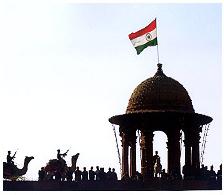Orphans of the Empire


Reviewed by Donna Rifkind
THE INHERITANCE OF LOSS
A Novel
By Kiran Desai
Kiran Desai's second novel tackles the lingering effects of colonialism on two kinds of South Asian people: those who attempt to leave India and those who remain. Set in 1986 in Kalimpong -- a Himalayan town in India's northeastern corner -- as well as in New York, the book details the beginning stages of a love affair. Here and there it unleashes some moments of bleak comedy, but the sweet-natured playfulness that cartwheeled through Desai's first novel, Hullabaloo in the Guava Orchard (1998), is conspicuously absent. Instead, the prevailing mood is implacable bitterness and despair.
Among those who find themselves immobilized in an ever-expanding web of debilitating Western influences are Jemubhai Patel, a Cambridge-educated retired judge whose unrequited Anglophilia has condemned him to a lifetime of loneliness and self-hatred; his convent-educated 17-year-old granddaughter, Sai, whose parents were killed in the Soviet Union, where her father was training to be an astronaut, and who now lives with the judge in his grand, crumbling mountain home; Gyan, a young accountant who abandons his budding romance with Sai when he joins a group of insurgents agitating for an independent Nepali state; and Biju, the only son of the judge's ill-treated cook, who roams silently through a series of menial New York restaurant jobs.
"Perfectly first-world on top, perfectly third-world twenty-two steps below": This is Desai's succinct description of Biju's working environment, where his position in Manhattan's rat-infested basement kitchens is firmly fixed. It's a position in which the rest of her characters are metaphorically pinned as well. All of them are exiles whether at home or abroad, and all of them struggle -- and fail -- to maintain a foothold and a shred of dignity in the encroaching morass of Westernization.
What unfolds in the novel is not so much a plot as a sequence of illustrations of Desai's worldview. There are shifts backward in time to the judge's Cambridge days, when "he worked at being English with the passion of hatred." There are descriptions of the slowly mounting insurgency in Kalimpong, where angry young men demanding a homeland shout and march "as if they were being featured in a documentary of war . . . these unleashed Bruce Lee fans in their American T-shirts made-in-China-coming-in-via-Kathmandu." The narrative swerves restlessly, as if the book itself were motoring up Kalimpong's dizzying mountain roads. It veers from Sai's fledgling romance with Gyan during the monsoon season to the judge's long-ago failed marriage, from the tragicomic anxiety of the judge's elderly neighbors during the insurgency to Biju's humiliations as a bewildered illegal alien, forever at the mercy of soulless embassy bureaucrats and heartless restaurant bosses.
Desai's grim imaginings are plainly designed to disturb and challenge complacent readers and to instill a sense of dislocation similar to that of her protagonists. But the force of her enterprise is diluted when her restlessness as a storyteller spills into impatience. Just as the reader begins to engage with a character, the narrative jumps to another time and place, another set of dire circumstances, making it difficult to develop any sort of uninterrupted sympathy.
The author's impatience reveals itself also through the constant introduction of minor characters, most of whom appear all too briefly, like Biju's friend Saeed Saeed, a Zanzibar native whose unflagging determination to succeed in America is one of the book's only flashes of optimism. Interspersed throughout the book, these smaller portraits are illuminating, but too distractingly sketchy to offer the reader an emotional connection.
With The Inheritance of Loss , Desai makes clear her intention to expand her reach from the narrow boundaries of her first novel to the global arena where big-name novelists like Salman Rushdie and Zadie Smith already confidently perform. In many ways, she has succeeded. The writing has a melancholy beauty here, especially in its sensuous evocations of the natural world: "white azaleas in flower, virginal yet provocative like a good underwear trick"; "mountains where monasteries limpet to the sides of rock." Her keen appreciation of contradiction enriches the book, and, if the integrity of her narrative is less than perfect, the integrity of her ideological convictions is absolute.
Yet what's most surprising about Desai's career thus far is that her first book was, in one important way, a more sophisticated effort than its successor. A small, brilliant fable, Hullabaloo in the Guava Orchard showed off its young author's profound comprehension that every novel, large or small, is at its heart an intimate thing. Its success depends on its author's unwavering attention to a group of characters who are the reader's emotional conduit to the book's wider drama. Some of that comprehension seems to have been left behind in Desai's leap to her second, more ambitious production.

0 Comments:
Post a Comment
<< Home